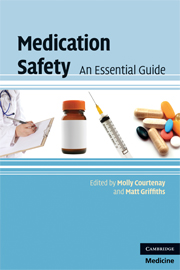Book contents
- Frontmatter
- Contents
- List of contributors
- Preface
- 1 Introduction to medication errors and medication safety
- 2 Safety in prescribing
- 3 Safety in dispensing
- 4 Safety in administering
- 5 Adverse drug reactions and drug interactions
- 6 Interface of care and communication
- 7 Parenteral drug administration
- 8 Calculations
- 9 Controlled drugs and patient safety
- 10 Reporting medication errors and near misses
- 11 Ensuring safety through evidence-based medicine
- Index
- References
4 - Safety in administering
Published online by Cambridge University Press: 22 January 2010
- Frontmatter
- Contents
- List of contributors
- Preface
- 1 Introduction to medication errors and medication safety
- 2 Safety in prescribing
- 3 Safety in dispensing
- 4 Safety in administering
- 5 Adverse drug reactions and drug interactions
- 6 Interface of care and communication
- 7 Parenteral drug administration
- 8 Calculations
- 9 Controlled drugs and patient safety
- 10 Reporting medication errors and near misses
- 11 Ensuring safety through evidence-based medicine
- Index
- References
Summary
Administration of a medication can be defined as ‘the giving by a nurse or authorised person of a drug to a patient’.
(Anderson & Anderson, 1995)Background
In the United Kingdom it is estimated that 2 500 000 medicines are prescribed for use within hospitals and the community setting every day (DH, 2004). Reports from the National Prescribing Centre (NPC, 2007) suggest that 15% of health expenditure is spent on prescribed medicines and this is the most common form of medicinal intervention.
Definition
A prescribed medicinal product is usually referred to simply as a medicine and for the purpose of this chapter a medicinal product will be referred to simply as a ‘medicine’.
The definition of a medicinal product is:
‘Any substance or combination of substances presented as having properties for treating or preventing disease in human beings.’
‘Any substance or combination of substances which may be used in or administered to human beings either with a view to restoring, correcting or modifying physiological functions by exerting a pharmacological, immunological or metabolic action, or to making a medical diagnosis’ (MHR A, 2007).
Medicinal products come in a variety of formulations. They may include: tablets, capsules, liquids, elixirs, syrups, pastilles, lozenges, mixtures, drops, creams, ointments, lotions, parenteral infusion, inhalations, sprays, transdermal patches, pessaries, rectal preparations, e.g. suppositories, enemas and also medication may be given by an injectable route. Th is is by no means an exhaustive list, but what is important is that, whenever a medical formulation is used, basic principles must be followed to ensure the safe administration of that product.
- Type
- Chapter
- Information
- Medication SafetyAn Essential Guide, pp. 43 - 62Publisher: Cambridge University PressPrint publication year: 2009



